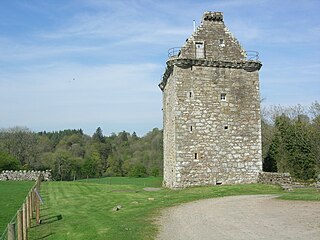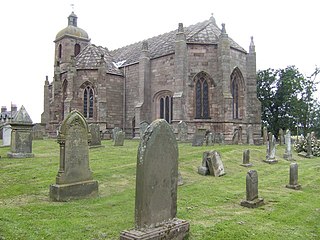James V was King of Scots from 9 September 1513 until his death in 1542. He was crowned on 21 September 1513 at the age of seventeen months. James was the son of King James IV and Margaret Tudor, daughter of Henry VII of England. During his childhood Scotland was governed by regents, firstly by his mother until she remarried, and then by his first cousin once removed, John Stewart, Duke of Albany. James's personal rule began in 1528 when he finally escaped the custody of his stepfather, Archibald Douglas, 6th Earl of Angus. His first action was to exile Angus and confiscate the lands of the Douglases.

Border reivers were raiders along the Anglo-Scottish border. They included both Scottish and English people, and they raided the entire border country without regard to their victims' nationality. They operated in a culture of legalised raiding and feuding. Their heyday was in the last hundred years of their existence, during the time of the House of Stuart in the Kingdom of Scotland and the House of Tudor in the Kingdom of England.

Hermitage Castle is a semi-ruined castle in the border region of Scotland. It stands in the remote valley of the Hermitage Water, part of Liddesdale in Roxburghshire. It is under the care of Historic Scotland. The castle has a reputation, both from its history and its appearance, as one of the most sinister and atmospheric castles in Scotland.
Sir Thomas Wharton, 1st Baron Wharton was an English nobleman and a follower of King Henry VIII of England. He is best known for his victory at Solway Moss on 24 November 1542 for which he was given a barony.
William Armstrong of Kinmont or Kinmont Willie was a Scottish border reiver and outlaw active in the Anglo-Scottish Border country in the last decades of the 16th century.

Walter Scott, 5th of Buccleuch, 1st Lord Scott of Buccleuch was a Scottish nobleman and famous border reiver, known as the "Bold Buccleuch" and leader of Kinmont Willie's Raid.

Clan Armstrong is a Scottish clan of the Scottish Borders.

Liddesdale is a district in the County of Roxburgh, southern Scotland. It includes the area of the valley of the Liddel Water that extends in a south-westerly direction from the vicinity of Peel Fell to the River Esk, a distance of 21 miles (34 km).
Caerlanrig - also spelled 'Carlenrig' - is a hamlet in the parish of Cavers, Borders, Scotland, lying on the River Teviot, 6 miles (10 km) north east of that river's source, and 10 miles (16 km) south west of Hawick.
Willie O Winsbury is a traditional English-language folk ballad. The song, of which there are many variants, is a traditional Scottish ballad that dates from at least 1775, and is known under several other names, including "Johnnie Barbour" and "Lord Thomas of Winesberry".

The Debatable Lands, also known as debatable ground, batable ground or threip lands, lay between Scotland and England. It was formerly in question as to which it belonged to when they were distinct kingdoms. For most of its existence, the area was a lawless zone controlled by clans of "border reivers" which terrorized the surrounding areas. It became the last part of Britain to be brought under state control in the middle of the 16th century by James V of Scotland, and was eventually divided between Scotland and England.
"Hughie Graham" or "Hughie Graeme" is an English-language folk song, existing in several variants. It was collected by Robert Burns. There is a printed version in the Bodleian Library under the title "The Life and Death of Sir Hugh The Grime". It is dated between 1672 and 1696. The Burns version was printed by James Johnson (engraver) in the Scots Musical Museum 1803. It is in volume 4 song no 303, pages 312 and 313. The Vaughan Williams Memorial Library lists several other versions in printed collections, including "Scottish Ballads" (1829) by Robert Chambers.

Gilnockie Tower is a 17th-century tower house, located at the hamlet of Hollows, 2.2 km north of Canonbie, in Dumfriesshire, south-west Scotland. The tower is situated on the west bank of the River Esk. It was originally known as Hollows Tower.

Clan Johnstone is a Border Reiver Scottish clan.
Johnie Cock is a traditional Scottish folk ballad, listed as the 114th Child Ballad and number 69 in the Roud Folk Song Index.
William Armstrong (1565–1649), known as Christie's Will, was a Scottish Borders freebooter of the 17th century, celebrated in a ballad by Sir Walter Scott.

Clan Little is a Scottish clan of the Borders. The clan does not currently have a chief and is therefore considered an armigerous clan. The Clan Little Society had a Guardian in place of a clan chief but, since his death in 2007, no suitable successor has appeared.

The Battle of Dryfe Sands was a Scottish clan battle that took place on 6 December 1593, near Lockerbie, Scotland. It was fought between the Clan Maxwell and Clan Johnstone after a hundred years of feuding between them. The Johnstones won a decisive victory over the Maxwells.

Mangerton Tower is a ruined Scottish tower castle house formerly belonging to the Armstrong family.

Thomas Peebles or Peblis was a Scottish glazier who worked for James IV, Margaret Tudor, and James V of Scotland.













